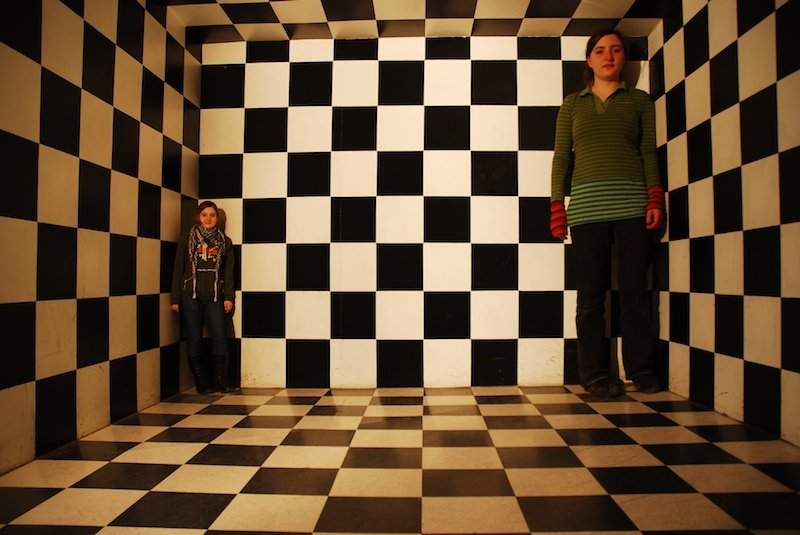Ames's room

- 3322
- 843
- Hugh Greenholt
AMES's room is an optical illusion designed in 1946 by the Adelbert Ames, an outstanding American ophthalmologist.
Seen from the outside, it seems that in this room there is a giant person, while another is dwarf. However, the trapezoidal room presents a distortion, since The walls, the roof and the floor are actually inclined.
One of the corners is also closer to the observer, so a person is perceived higher than the other.
Entering the AMES room allows us The mind actively works to try to define its environment. It is no accident that Adelbert Ames is the founder of transactionism, a quite interesting psychological current.
Perhaps AMES has been inspired by Hermann Helmboltz, who was also a remarkable medical and physicist, concerned about vision theories, mathematics, space ideas and visual perception, color, perception of sound and others.
In any case, AMES demonstrates with its famous room that the perceptual capacity is not simply given, as well as the world, but both define themselves, in a simultaneous and carried out process together.
So, the subject is not a passive entity waiting to be impressed by the environment, but acts actively to the extent that it is surrounding it.
If any conflict or knot appears that does not allow you to fully understand, then A dialogic process begins with the environment, trying to make a readjustment in your experience.
That is why, for the transactionist's current, the world that each person knows is the result of the interaction he has held with the environment.
The AMES room and perceptive judgments
Another aspect that reflects the optical illusion of AMES's room is that perceptive judgments are not objective, but subjective.
There is a large dose of subjectivity in the interpretations of the individual, Well, it is the experience of each subject and the interaction he has sustained with the environment, which allows to build judgments.
In this way it is demonstrated that the world is a space in which the needs and expectations of human beings are overturned, as a product of the way it is and is in the world, because, as the psychologist would say Jorge Mendoza García in his study on the social construction of knowledge, the subjects are not in a laboratory, isolated from the world.

The optical illusion of Ames's room was a door for psychology to think about the environment and in which perception was defined as a dialogue of men and the environment.
That is, the vision of stimulus-response is in disuse when being considered too simplistic, from environmental psychology, to adopt a position in which the transaction that the subject does with the environment predominates.
In addition, The interpretations that each subject makes are only possible thanks to the perception and to the principles that govern the life of men.
If a knot appears, or something difficult to interpret, that is, a fact that comes to contradict the experience of the world -as with the perspective of depth in the room of Ames -then the man enters dialogue with the environment to make an internal readjustment.
How is the world really?
After being confused by the illusion of AMES's room, it is possible to deduce that It is we who create the world through interaction Or, rather, through our transactions with the environment.
In addition to this illusion, other AMES experiments also allow us of a distorted perception.
However, when we notice that what we observe cannot be possible, our experience reaches itself, as well as our behavior with the environment.
This can be affirmed that The environment is not an empty or neutral space, but everything we find in it is due to our cultural procedure.
In this cultural construction the concept of time becomes important. So, We have the categories time and space To order the world, And in which only a review of the thought of Immanuel Kant can be made to understand how we order the world.
The past, the present and the future are essential in our understanding of the world; Even our definition is not static either, but is immersed in a world that is dynamic, in which both man and environment define each other.
Ames's room is undoubtedly the passage towards great reflection on our perception.
Discover the best optical illusions
Bibliography
- AMES JR, A. (1951). Visual perception and the rotating trapezoidal window. Psychological Monographs: General and Applied, 65(7), I.
- Behrens, r. R. (1987). The Life and Unusual Ideas of Adelbert Ames, JR. Leonardo, twenty(3), 273-279.
- Castelluccio, l. Neuroscience and optical illusions neuroscience and optical illusions.
- Mendoza Garcia, J. (2015). Another look: the social construction of knowledge. Polis, eleven(1), 83-118.
- Puell Marín, M. C. (2019). Organization and illusions of perception.

